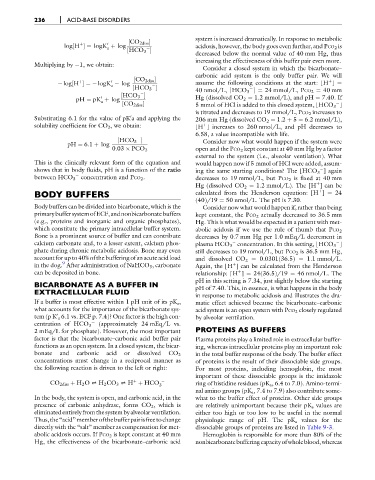Page 245 - Fluid, Electrolyte, and Acid-Base Disorders in Small Animal Practice
P. 245
236 ACID-BASE DISORDERS
system is increased dramatically. In response to metabolic
½CO 2diss
þ
log½H ¼ logK þ log acidosis, however, the body goes even further, and PCO 2 is
0
a
½HCO 3
decreased below the normal value of 40 mm Hg, thus
increasing the effectiveness of this buffer pair even more.
Multiplying by 1, we obtain:
Consider a closed system in which the bicarbonate–
carbonic acid system is the only buffer pair. We will
½CO 2diss
þ
log½H ¼ logK log assume the following conditions at the start: [H ] ¼
0
þ
a
½HCO 3
40 nmol/L, [HCO 3 ] ¼ 24 mmol/L, PCO 2 ¼ 40 mm
½HCO 3
pH ¼ pK þ log Hg (dissolved CO 2 ¼ 1.2 mmol/L), and pH ¼ 7.40. If
0
a
½CO 2diss 5 mmol of HCl is added to this closed system, [HCO 3 ]
is titrated and decreases to 19 mmol/L, PCO 2 increases to
Substituting 6.1 for the value of pK a and applying the 206 mm Hg (dissolved CO 2 ¼ 1.2 þ 5 ¼ 6.2 mmol/L),
0
solubility coefficient for CO 2 , we obtain: [H ] increases to 260 nmol/L, and pH decreases to
þ
6.58, a value incompatible with life.
½HCO 3 Consider now what would happen if the system were
pH ¼ 6:1 þ log
0:03 PCO 2 open and the PCO 2 kept constant at 40 mm Hg by a factor
external to the system (i.e., alveolar ventilation). What
This is the clinically relevant form of the equation and would happen now if 5 mmol of HCl were added, assum-
shows that in body fluids, pH is a function of the ratio ing the same starting conditions? The [HCO 3 ] again
between HCO 3 concentration and PCO 2 . decreases to 19 mmol/L, but PCO 2 is fixed at 40 mm
þ
Hg (dissolved CO 2 ¼ 1.2 mmol/L). The [H ] can be
BODY BUFFERS calculated from the Henderson equation: [H ] ¼ 24
þ
(40)/19 ¼ 50 nmol/L. The pH is 7.30.
Body buffers can be divided into bicarbonate, which is the Consider now what would happen if, rather than being
primarybuffersystemofECF,andnonbicarbonatebuffers kept constant, the PCO 2 actually decreased to 36.5 mm
(e.g., proteins and inorganic and organic phosphates), Hg. This is what would be expected in a patient with met-
which constitute the primary intracellular buffer system. abolic acidosis if we use the rule of thumb that PCO 2
Bone is a prominent source of buffer and can contribute decreases by 0.7 mm Hg per 1.0 mEq/L decrement in
calcium carbonate and, to a lesser extent, calcium phos- plasma HCO 3 concentration. In this setting, [HCO 3 ]
phate during chronic metabolic acidosis. Bone may even still decreases to 19 mmol/L, but PCO 2 is 36.5 mm Hg,
accountfor upto 40% of the buffering ofan acute acid load and dissolved CO 2 ¼ 0.0301(36.5) ¼ 1.1 mmol/L.
9
in the dog. After administration of NaHCO 3 , carbonate Again, the [H ] can be calculated from the Henderson
þ
can be deposited in bone. relationship: [H ] ¼ 24(36.5)/19 ¼ 46 nmol/L. The
þ
pH in this setting is 7.34, just slightly below the starting
BICARBONATE AS A BUFFER IN pH of 7.40. This, in essence, is what happens in the body
EXTRACELLULAR FLUID
in response to metabolic acidosis and illustrates the dra-
If a buffer is most effective within 1 pH unit of its pK a , matic effect achieved because the bicarbonate–carbonic
what accounts for the importance of the bicarbonate sys- acid system is an open system with PCO 2 closely regulated
tem (p K a 6.1 vs. ECF p. 7.4)? One factor is the high con- by alveolar ventilation.
0
centration of HCO 3 (approximately 24 mEq/L vs.
2 mEq/L for phosphate). However, the most important PROTEINS AS BUFFERS
factor is that the bicarbonate–carbonic acid buffer pair Plasma proteins play a limited role in extracellular buffer-
functions as an open system. In a closed system, the bicar- ing, whereas intracellular proteins play an important role
bonate and carbonic acid or dissolved CO 2 in the total buffer response of the body. The buffer effect
concentrations must change in a reciprocal manner as of proteins is the result of their dissociable side groups.
the following reaction is driven to the left or right: For most proteins, including hemoglobin, the most
important of these dissociable groups is the imidazole
þ
CO 2diss þ H 2 O ⇄ H 2 CO 3 ⇄ H þ HCO 3 ring of histidine residues (pK a , 6.4 to 7.0). Amino-termi-
nal amino groups (pK a , 7.4 to 7.9) also contribute some-
In the body, the system is open, and carbonic acid, in the what to the buffer effect of proteins. Other side groups
presence of carbonic anhydrase, forms CO 2 , which is are relatively unimportant because their pK a values are
eliminatedentirelyfromthesystembyalveolar ventilation. either too high or too low to be useful in the normal
Thus,the“acid”memberofthebufferpairisfreetochange physiologic range of pH. The pK a values for the
directly with the “salt” member as compensation for met- dissociable groups of proteins are listed in Table 9-3.
abolic acidosis occurs. If PCO 2 is kept constant at 40 mm Hemoglobin is responsible for more than 80% of the
Hg, the effectiveness of the bicarbonate–carbonic acid nonbicarbonatebufferingcapacityofwholeblood,whereas

